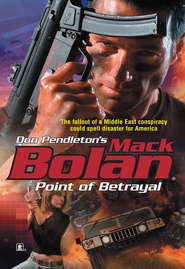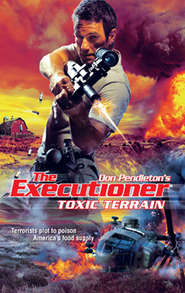По всем вопросам обращайтесь на: info@litportal.ru
(©) 2003-2025.
✖
Deadly Payload
Автор
Год написания книги
2019
Настройки чтения
Размер шрифта
Высота строк
Поля
“Have the Israeli air force go on alert. We’ve stumbled on another bit of provocation,” he told her. “That barge is a floating launch pad.”
“Should we get someone scrambled out to you?” Price asked.
“Syria is on full alert as it is. Any friendly aircraft who’d hit this place would only provoke them and their allies in Lebanon,” the Briton explained.
“What kind of enemy forces are you looking at?” Price continued.
“Thirty to forty ground troops. Lord know how many in the trucks, but a group went out on the barge,” McCarter explained.
Price covered the mouthpiece on her end for a moment, then spoke to McCarter again. “An air strike might make Damascus squirrelly, but we have a way around that.”
“What’ve you got?” McCarter inquired.
“An artillery unit in northern Israel. They lob some explosives across the border into Lebanon every so often,” Price mentioned.
McCarter frowned. “We’re danger close, and I’d like to take one of the trailers intact. If we can get hold of the hardware and servers used to operate their drones, we could slip you chaps into the back door for some deep-down digging.”
“Ten to one’s tough odds, David,” Price said.
“Worse than that,” McCarter admitted. “I sent Cal and Rafe to the barge to sink it.”
“We drop one shell in the vicinity. It’ll cut the odds, and less likely to blow everything to hell.”
The Briton handed the phone to Hawkins and contacted James and Encizo on his Los Angeles SWAT Headset—LASH. “How soon to the barge?”
“Another two minutes,” Encizo said.
McCarter took the phone back from Hawkins. “How far is the artillery site from here?”
Price gave the coordinates.
“A minute and a half flight,” McCarter figured.
“That’s what we figured. Coordinates?” Price asked.
McCarter handed the phone to Manning, who had been observing the operation. The Canadian read off coordinates he figured through his map skills. Manning’s mathematical skills and navigational abilities were second to none, and if anyone had a chance to spot for an artillery shell fired from dozens of miles away without benefits of laser targeting, it was him. Manning gave the Briton the phone.
“Your artillery is on its way,” Price promised. “It’ll be there by the time the others make their move on the barge.”
“What can we expect?” McCarter asked.
“We have a reserve unit dropping some payback on a Palestinian group. You’ll get a 155 mm Copperhead from a Doher,” Price said.
“Cover your heads, lads. It’s going to get loud,” McCarter promised.
Manning slung his sniper rifle and drew his Glock 34. He’d eschewed a machine pistol for the precision rifle, but compromised by carrying two of the chosen sidearm for this mission. The second Glock was set up for close-quarters combat, equipped with a blunt four-inch suppressor, a 20-round extended magazine and, on a rail under the barrel, a mounted gun light. The suppressor provided a semblance of stealth without sacrificing stopping power for the hollowpoint rounds within, and the light, even if it wasn’t activated, served as a means of steadying the already mild recoil of the G-34 in rapid fire. The Glock was also one of the most accurate and easy-to-shoot handguns on the planet, second only to McCarter’s own beloved Browning Hi-Power.
McCarter relegated his MP-5 to a backup role, drawing his Browning in anticipation of a fast, nasty mop-up. And it would be quick and nasty. While an artillery shell would take out a good number of the enemy force, no barrage would ever completely obliterate opposition. But it would soften them up. Hawkins stuck with his MP-5, not trusting his skill with a handgun to be as high as Phoenix veterans Manning and McCarter.
The Briton looked out over the water.
The two minutes that James and Encizo had estimated were almost up.
K NIFING THROUGH THE WATER like they were born to it, Rafael Encizo and Calvin James closed on the barge. The Phoenix Force pair drew their fighting knives in anticipation of first contact with the crew of the barge, but their observations showed that the men on board were busy preparing unmanned aerial vehicles for launch. Just before they reached the hull, they noted canisters labeled with the universal symbol for biohazard.
Encizo and James shared a nervous, knowing glance as they realized the implications of their failure. Whoever these men were, they were planning to launch an attack, utilizing a similar lethal contamination that devastated the Syrian camp. Four UAVs sat on the deck of the barge, laden with four canisters each on underwing mounts normally meant for Maverick antitank missiles. The size of the containers promised a potential of death for thousands if they struck in a metropolitan center.
Both Phoenix force commandos realized that Israel had many port cities that would provide tempting targets for the airborne death-bringers.
On the shore, a thunderclap split the air, which served as the starting gun for their assault.
Encizo gripped the rail of the barge with one hand and hauled himself onto its deck, staying low. In his off hand, the Cold Steel Tanto Combat knife was held in an icepick grip, the chisel-pointed, razor-sharp blade shielded against his forearm so it wouldn’t reflect the work lights on the deck, even though he had the concealment of a crate. James surfaced and crawled onto the barge fifteen feet away, also behind a transport container. The barge itself was twenty yards long, but much narrower by a factor of four to one, five yards wide. It was a garbage scow that had been pressed into service as an aircraft carrier to launch the drones. Since the UAVs were designed for short takeoff and landing, even with underwing payloads, the length would be enough for the launching task.
The engines on the first one strummed to life and Encizo realized that if it started moving, tragedy would fall on an Israeli city. The stocky Cuban sheathed his combat blade and shouldered his machine pistol, quickly detaching the suppressor on the MP-5, knowing that he’d need every ounce of power to damage even the relatively flimsy and disposable aircraft.
He focused on the engine cowling, situated two feet above and away from the biohazard canisters mounted underwing, and opened fire as soon as he had a clear sight picture. The German-made machine pistol chattered out its popping death song. Men on deck dived for cover at the sound of Encizo’s attack, shocked at his sudden appearance. The engine cowling perforated in a dozen places as full-metal-jacketed bullets smashed through the pistons running its propeller.
The Predator knockoff lurched forward a few feet, smoke pouring from the damaged engine, but it rolled to a halt as the propeller caught and froze on broken pistons.
James moved from behind cover as soon as Encizo opened fire and concentrated on two of the enemy who were reaching for their weapons. All the men on the barge were armed with at least handguns, and the two who were reacting had AKM folding-stock assault rifles. James ripped a burst of suppressed fire into one of them, stitching him through the face and shoulders. The other man had gotten to his knees and fired a quick salvo from the hip that missed the black Phoenix Force pro by inches. James tucked down deeper and sliced the rifleman from crotch to throat with a half dozen Parabellum slugs. The enemy gunner flopped over the side of the barge, disappearing into the Mediterranean.
Encizo scurried behind the cover of his crates, keeping one step ahead of the handgun fire that chased him. The Cuban took a few potshots, but was hampered by the fact that four drones were parked on the deck laden with poison-packed containers. He didn’t want to risk dumping contagion into the Mediterranean to have it wash ashore in a populated area.
Saving one city would have been a waste if other civilians were sacrificed because of sloppy work. He still fired a few shots, high and wide, to keep their attention on him and give James, who had a better angle on the defenders, a chance to take them out.
James didn’t envy Encizo’s position as human target, and he ripped off more bursts from his machine pistol, tagging every enemy target he could find. Unfortunately the enemy had realized that as long as they cowered behind the biohazard containers, they were relatively safe.
James disabused them of that concept by dropping prone and targeting legs and feet with his machine pistol. Bullets smashed violently through tarsal bones and kneecaps with equally devastating and crippling results. The conspirators crashed helplessly to the deck, falling away from the lethal cylinders of contagion that they sought to use as shields. Flat on their backs and bellies, they were easy targets for James and Encizo to finish off.
The Cuban crouched behind a crate and swept fallen survivors with submachine-gun fire. It was a cruel and callous effort, gunning down the injured, but these men still held handguns that they could use in a last-ditch effort to breach one of the bioweapon containers as a final act of revenge.
“All clear?” James asked, moving swiftly around the bodies of the dead and the inert drones.
“No movement,” Encizo answered.
“We can’t leave these things,” James stated, looking toward the shore.
“No,” Encizo agreed, “but we can take them with us.”
James looked at the deckhouse. “I’ve got it.”
“Maybe we won’t be too late to help out,” Encizo concluded as the barge turned toward the shore.
I T WAS NO DIFFICULT TRICK to misdirect a laser-guided 155 mm artillery shell utilizing a broadcast pulse from a satellite slaved to Stony Man Farm’s control. The M-712 Copperhead was one of the first and most successful of laser-guided, cannon-launched munitions, with a range of ten miles, and carrying nearly fifteen pounds of Composition B as its warhead. With a velocity of detonation at 8050 meters per second, 1100 meters per second faster than TNT, the Copperhead shell possessed awesome destructive ability. Aaron “The Bear” Kurtzman distracted the single Copperhead round from a flight of twenty aimed across the northern border between Israel and Lebanon against a Syrian-backed militia. Well within the ten-mile range of the laser-guided shell, the M-712 altered its guide path and split off from the main flight.
Kurtzman continued to track their hijacked shell in flight, painting Manning’s target via a satellite-mounted laser. The computer genius took into account atmospheric refraction, but he held his breath as the warhead, loaded with the equivalent of fifteen pounds of TNT, was dropped, as McCarter had noted, “danger close” to the men of Phoenix Force. One variation in humidity or air temperature and there was a strong possibility that there wouldn’t be enough left of McCarter, Manning and Hawkins to scoop up inside a matchbox.
The satellite registered the detonation of the Copperhead, and Kurtzman looked at his screen for the IFF codes on Phoenix Force’s LASH communicators.











